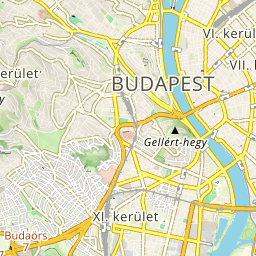St Imre Church
The church with the Lake Feneketlen in front is a marvelous sight in the center of South Buda. The silhouette of the distinctive twin-towered church appears in the logo of Újbuda district as well.

On the left of the church lies the St Imre Cistercian High School of Buda. Originally the school building and a cloister were planned on the two sides of the church and a colonnade (a passage of columns) with statues to connect them. Finally, the plan for the cloister remained unaccomplished.

Despite the neobaroque elements the church has a simple structure with a clean-lined and clear composition. The ceiling is decorated with painted panels, the facade between the two towers features statues of distinguished members of the Cistercian order. The towers used to have backlit clocks planned to be restored in a renovation project.

The Cistercian order started off in District 11 in 1912, the same year when their high school was founded with a temporary home in a primary school in Váli Street. Abbot of Zirc, Remig Békefi, the owner of the plot at 3-7 Villányi út (formerly Prince St Imre Street) planned to build a church, a school and a cloister there. By 1924, a temporary Church of Our Lady of Assumption was constructed together with a parish house to serve the Kelenföld Parish of Our Lady of Assumption founded in 1923.

The foundation stone of St. Imre Church designed by Gyula Wӓlder was laid in 1936. The church was dedicated on St Imre’s Day in 1938 by Prince Primate Jusztinián Serédi. The designer, Gyula Wӓlder was an outstanding architect of his time designing several buildings in Budapest and countrywide such as the headquarters of Budapest Public Transport Company in Akácfa Street or the monumental brick building in Madách Square. He built his own house nearby St Imre Church, in Himfy Street, currently used as the parish office of the church.
The name of the church and the Cistercian high school was a reference to its location within the district known as St Imre Town since 1930. After the dedication of the new church the temporary Church of Our Lady of Assumption got pulled down to free up the site for a cloister. Due to WW2 this plan remained unaccomplished.

The communist government banned monastic orders in the 1950’s including the Cistercian order. Administration of the parish was taken over by the Archdiocese of Esztergom. The church underwent a renovation internally between 1972 and 1975, external works began a year later and were completed in 1979.
In 2001, a Kuno Klebersberg Monument was erected between the church and the high school to commemorate his substantial contribution as a Minister of Religious and Education Affairs to establishing the Cistercian school and maintaining the order. The sculpture group made by Jenő Grantner was originally unveiled in District 4 in 1939. Later during WW2 it was badly damaged and removed. After a restoration in 2000 it was placed in District 11. The central figure in the middle portrays Kuno Klebersberg accompanied by minor figures of a man and a woman representing science and arts, respectively.

-

Photo: funiQ -

Photo: funiQ -

Photo: funiQ -

Photo: funiQ -

Photo: funiQ -

Photo: funiQ
On the left of the main entrance a chapel was constructed in 2016 designed by architect Tibor Orbán. It was named after the aristocrat and physician László Batthyány-Strattmann, also known as “the doctor of the poor”. The chapel mixes traditions with contemporary style.
St. Imre Church occasionally hosts exhibitions and concerts and during Advent passers-by are attracted by façade projection. The church is open to visitors in opening hours except during Mass. Group visits are possible by prior request.

Contacts:
- Phone: +36 1 466 58 86
- E-mail: iroda@szentimre.hu
- Web: www.szentimre.hu
- Opening hours:
- The church opens one hour prior to Masses.
- Masses:
- Monday-Saturday: 7:30, 18:00
- Sunday: 7:30, 9:00, 11:00, 18:00, 21:00
Recommended tours
A tour in the heart of Újbuda A walk around the cultural center of South Buda answers how a building was named after 500 silver coins or how a church still in use today was built on the first floor of another building, or how youngsters had fun at the Park Stage of Buda.
A scenic walk on Gellért Hill A World Heritage Site, a landmark of Budapest, cradle of hot springs, a witness of our history, the best date location and a place with the greatest view over Budapest. A scenic walk from top to bottom from St Gellért Square through the Arboretum of Buda to the Lake Feneketlen.








